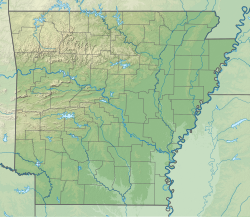| Queen Wilhelmina State Park | |
|---|---|
 Park lodge | |
| Location | Polk County, Arkansas, United States |
| Coordinates | 34°41′08″N94°22′12″W / 34.68556°N 94.37000°W [1] |
| Area | 460 acres (190 ha) |
| Elevation | 2,516 feet (767 m) [1] |
| Established | 1957 |
| Administered by | Arkansas Department of Parks, Heritage, and Tourism |
| Designation | Arkansas state park |
| Website | Queen Wilhelmina State Park |

Queen Wilhelmina State Park is a unit of Arkansas Department of Parks and Tourism in the Ouachita Mountains.
Contents
The original "Castle in the Sky" lodge was built in 1898 on 2,681-foot Rich Mountain, in Polk County, Arkansas. The park is on Talimena Scenic Drive — northwest of Mena, Arkansas and east of the Oklahoma state line. It is the only lodge open on the 235 mile Ouachita Trail. It is located on Arkansas’ second highest peak, Rich Mountain. [2]
The lodge has 40 guest rooms, a restaurant, a lobby and meeting room. The campground and trails remained open during the renovation. The park is one of the park system's eight mountain parks. [3]
